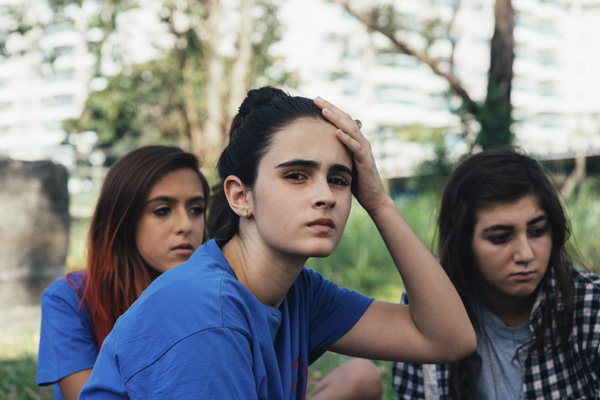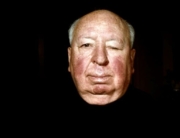Four 15-year-old school chums live in a high-rise in the upper-class outskirts of Rio de Janeiro. The girls are goofy, occasionally sly, bored with school, obsessed with sex, and, most recently, death. You see, there’s a serial killer dumping bodies in the grassy outskirts of town. This fascinates the quartet, particularly Michele (Julia Roliz), who dreams up elaborate scenarios of her demise, usually in violent and sexually deviant ways, and Bia (Valentina Herszage), the quietest but most astute member of the group. Bia has a boyfriend with whom she wants to go all the way, but, like a good Catholic boy, he resists, increasing her frustration and fascination with the murders.
This is the starting point of Kill Me Please, by first-time feature director Anita Rocha da Silveira, who also wrote the script. She draws a direct parallel, as so many other filmmakers have, between sex and death, but she uses the age of her characters to bring that observation to a phantasmagoric boil. The plot itself is simple. The four teens go on with their lives, adding the fear into their thinking and turning it into wonder and excitement that kicks the dullness of school and home up a notch. Then they discover a dying girl, who is obviously the serial killer’s victim, in the weeds. Bia takes her hand and attempts to keep her alive. She fails, and this closeness to death changes her.
Da Silveira has a definitive affinity for these young women, and she understands what makes them tick, how boredom and confusion can lead to, well, some bad life decisions, and that the same boredom and confusion makes up a lot of the drama inherent in teenage life. When a serial killer is added to the mix, you understand why Bia gets drawn to the idea of being a murderer and being a victim.
Da Silveira also has a sense of humor. There are slow takes of the kids making out while dreamy pop music plays in the background. There are other kids making out on the edges of scenes who have nothing to do with the four main teens. It’s oddly amusing and a comment on how teens’ hormones run free and also how movies portray young people. Of course, if kids have free time, they’re going to make out. There are a couple of scenes where, after school, the gang converges on a vendor, screaming for soda like an angry mob out for vengeance. The four also go to a church with a pastor, a twenty-something buxom woman, who literally salsas for Christ. An extended dance party sequence is alternately mundane, creepy, and hysterical while neatly encapsulating and exploiting the anxieties of the quartet.
I should stress this is not a horror movie. It is rarely bloody and almost never violent. It’s more of a free-form examination of the adolescent mind. It therefore makes sense when the narrative flow is interrupted by, say, a dance routine or an actress staring directly at the camera as blood flows copiously from her mouth. Da Silveira is part-Lynch, part-social theorist, and part Agnès Varda. It’s an odd combination that makes for a herky-jerky viewing experience. Because her attempt at realism is so accurate, the surrealistic touches almost seem like a formalist tic. Her influences haven’t been absorbed in a more fluid manner, but given time, they will. And when that happens, she’ll be a force to reckon with.







Leave A Comment